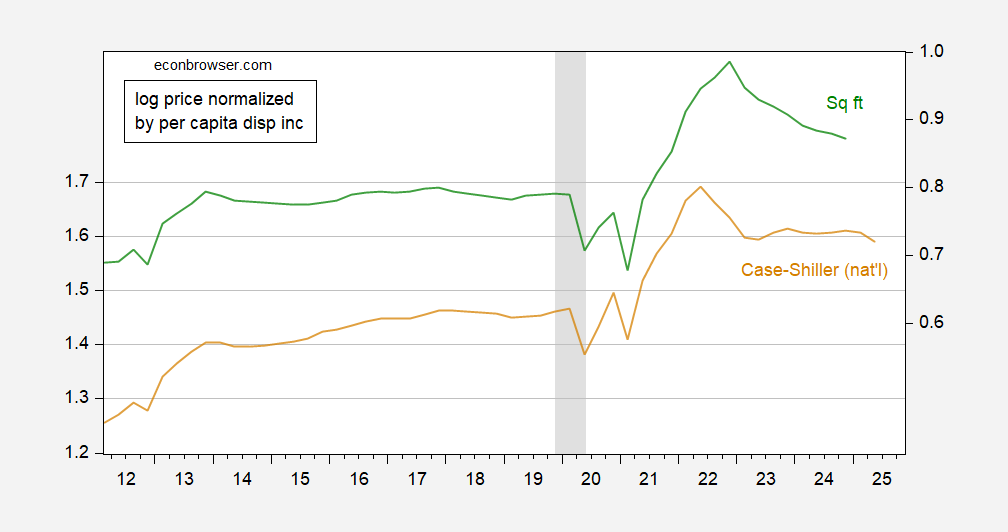To quote:
We read much about how housing is now “unaffordable”, but is that true?
We bought a 2300 sf home in 1979 with a 10.5% mortgage interest rate (a step up from our 1200 sf starter home). It was a bit of a strain, but our second child was on the way so we bit the bullet. Now it seems that this generation whines about housing being unaffordable and wants the government to “do something” about it.
Mortgage rates: https://fred.stlouisfed.org/series/MORTGAGE30US
Yeah, up from “free money”, but still in line with much of the last 50 years and far lower than the 1980-85 period that was supposed to be so “affordable” for “boomers”.A little AI Assist search comes up with this:
Search Assist
“Since 1970, the average size of new single-family homes in the U.S. has increased significantly, nearly doubling in size. For example, the median size of a new home was about 1,595 square feet in 1980 and grew to approximately 2,386 square feet by 2018.”Search Assist
“Inflation-adjusted home prices per square foot have remained relatively stable since 1973, averaging around $116 per square foot in 2015 dollars.”So the issue of homes being unaffordable is that young couples are no longer content with a 1,200 sf “starter home” that might be 30-years old. They “need” something twice as large and brand new.
Home unaffordability is a myth.
“Whatabout” everything else. Okay, what about it?
Again, no “free money”, but besides the period of reckless government spending in 2020-22 and resulting inflation, current price increases are not historically out of line.
https://mitsloan.mit.edu/ideas-made-to-matter/federal-spending-was-responsible-2022-spike-inflation-research-showsPersonal income increases have followed the historical trend.
https://fred.stlouisfed.org/series/PIUnemployment rate not so bad.
https://fred.stlouisfed.org/series/UNRATEMaybe it’s time to stop whining so much.
OK, some data:
House prices from 1979 onward:
Figure 1: FHFA House Price Index, deflated by CPI-ex shelter (blue), normalized by average hourly earnings (tan), both in logs, 1979Q1=0. NBER defined peak to trough recession dates shaded gray. Source: FHFA, BLS via FRED, NBER, and author’s calculations.
Expressed either way, the cost of a house has risen relative to the price level or to average hourly earnings of production and nonsupervisory workers.
What about real interest rates? These are most relevant for the non-liquidity constrained agents.
Figure 2: 30 year mortgage rates minus expected 10 year CPI inflation rates (blue), and 30 year mortgage rates minus expected 10 year CPI inflation rates minus ex post future year house price appreciation (tan), both in %. NBER defined peak to trough recession dates shaded gray.Source: Freddie Mac, FHFA via FRED, Blue Chip and Livingstone via Phildelphia Fed, NBER, and author’s calculations.
The conventional real rate is shown as the blue circles/lines. However, for assets, the appreciation of the asset over time should be included. The tan line incorporating only one year of future ex post price appreciation is shown. This real rate is approximately 2 percentage points what held in 1979.
One implication of Figure 2 is that bringing down the nominal rate in and of itself will not have a large influence on the “real rate of interest” for housing, defined as an investment.
We have more data over the recent period, particularly with respect to repeat-sales prices (the Case-Shiller index). Hence, in using this index, we are controlling for size of house. In addition, we have average and median prices per square foot of housing.
Figure 3: FHFA house price index (blue), Case-Shiller house price index – nationwide (tan), and median price per square foot of housing (green), deflated by CPI ex-shelter. NBER defined peak-to-trough recession dates shaded gray. Annual square foot price measures linearly interpolated to quarterly frequency. Source: FHFA, S&P, BLS via FRED, Census Bureau, NBER, and author’s calculations.
None of the calculations include measures of credit rationing, which would be important given changing restrictiveness of lending requirements.
What about affordability in terms of income? I could repeat the calculations using average hourly earnings, but since the household distribution of outside work has changed, perhaps it’s more useful to show series normalized by per capita disposable income.
Figure 4: Case-Shiller house price index – national normalized by per capita disposable income (tan, left scale), and price of square foot of housing – median normalized by per capita disposable income (green, right scale), both in logs. NBER defined peak-to-trough recession dates shaded gray. Annual square foot price measures linearly interpolated to quarterly frequency. Source; S&P, BEA via FRED, Census Bureau, NBER, and author’s calculations.
In short, I don’t think people are “whining” without some reason.




